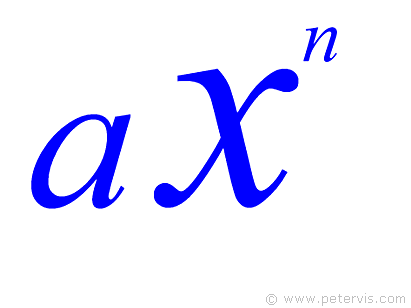Integration Basics

Integration is the opposite of differentiation. Here is the basic general rule for operating on axn, where the coefficient "a" is a number.
As you can see you start out by adding 1 to n, and you use the same result to divide a by it, hence n+1 also goes underneath a. This brain-training graphic may help get the idea. You might need to stare at it for a while until you get it.

Here is the basic general formula to integrate xn. As you can see, you just add 1 to the power and divide by the same value. This formula works fine providing n is not equal to -1. If n = -1 then it becomes 1/x and the integral of that is lnx.
Integrate x^2 - Example

Here is an example showing how to integrate x^2, also known as x², or x to the power 2. In this example a = 3. The rules are very simple, and all you have to do is to add 1 to the power, which makes 3, then divide by 3. In this particular example since a = 3, it cancels out and you are left with x³.
Integration Examples
Let us say that you needed to integrate x² and a = 1. Then the answer would be x³/3. Below is a list of examples for different powers of x: x^2, x^3, x^4, x^5, and x^6.





As you can see, integration is very simple. A six year old could do it if explained properly. Just add one to the power and divide by the result. After a while, it will be like second nature and you will not even need to think about it.
Definite Integrals

With definite integration, there is an extra bit of work that you will have to perform because definite integration is to do with calculating the area under the curve, and the result generally tends to be numerical.
Definite Integration: If your integral symbol has numbers denoted by a and b written as shown in the diagram above then you can be sure that you are working with a definite integral, where a and b are upper and lower limits along the x axis.

The area under the curve bounded by the parameters a, and b, are upper and lower limits along the x-axis as shown above.
Once you have integrated the function you are expected to substitute x with the values a, and b to find a numerical value which will be the area. This value will be the area shaded in yellow and bounded by the curve made by f(x) and the upper and lower limits a, and b.

The standard formula for area under a curve is this. As you can see it will not be much use to you if you did not know what to do with a, and b.
Area under a Curve Example

Find the area bounded by the curve x² between the limits x=1 and x=2.

Once you have differentiated it you place it into square brackets and write the upper and lower limits again. That is like saying that you are going to do the same operation twice. First you will substitute 2 for x, and then second time substitute 1 for x.

Substitute the top value for x, which gives the first term, and then substitute the lower value for x, which gives the second term. You then subtract the two terms.

Finally, this is the answer, which is the area under the curve.
Indefinite Integrals

Indefinite Integration is much simpler because with this type of integration, there are no upper and lower limits. You integrate the function and just leave it at that.
Integrate sin x

Integrate cos x

Integrate tan x

Integrate ln x

Integrate e^x

Rules for e: Euler’s number is the easiest to integrate and differentiate as it is a mathematical constant raised to the power x aka e^x. As you can see, a calculus operation will have no effect on it.
Integrate 1/x

Calculator Solvers
Some of the modern calculators can also perform this function on a limited number of mathematical identities. Whilst this option is available, it is actually better to learn the basics to build intuition. Nearly all the "advanced" mathematics relies upon this simple basic theory therefore it is vital that you learn it instead of relying upon a calculator to work it out for you.